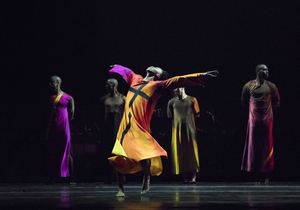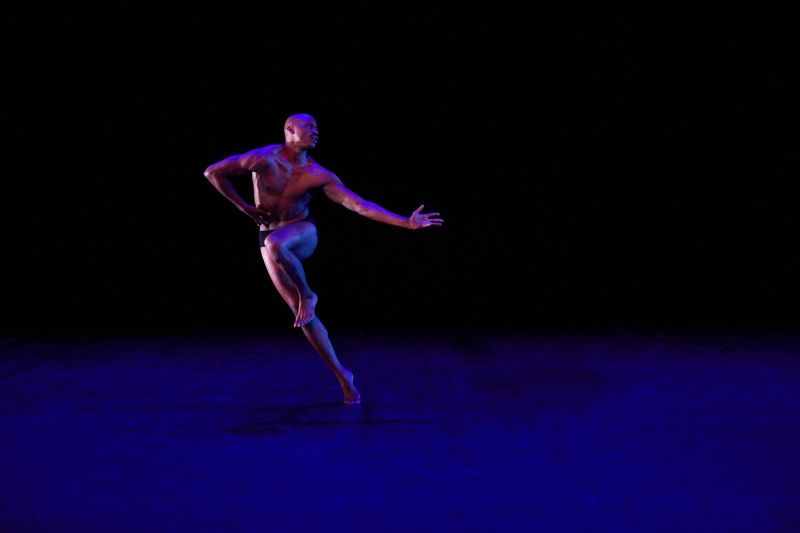Review: ALVIN AILEY AMERICAN DANCE THEATER: BATTLE 10TH ANNIVERSARY at City Center
Artistic Director Robert Battle celebrates a decade of his choreographic variety through December 19th

Alvin Ailey American Dance Theater is back at City Center through December 19 with premieres, repertory favorites, new productions and a "greatest hits" retrospective of Robert Battle's choreography for the company, Battle 10th Anniversary.
The program features a sample platter of current Artistic Director Robert Battle's tenth anniversary in that role. Like a master chef, the selections of his dance offerings spanning a decade are palatable and varied yet complimentary.
Watching the evening unfold, one can observe threads that string the pieces together with Battle's favorite movements that make up his signature style. But one can also appreciate Battle's chameleon-like ability to adapt the physicality to his myriad eclectic music choices ranging from liturgical to jazz scatting to funky, soulful tunes.
The evening begins strongly with MASS, a large group piece that calls to mind mass gatherings of a spiritual, though not necessarily religious nature. The work is set to a score by John Mackey, a regular collaborator and friend. It showcases the ritualistic movements that are often recognized in Battle's choreography. The movements and music begin with restraint and repetition, like a moving meditation. Spontaneously, it evolves into a frenzy of frenetic dancing and bombastic percussion, evoking an exorcism or bacchanal with allusions to the music and famed choreographic interpretations of Stravinsky's "The Rite of Spring."
.jpg)
Initially created in 2004 for Julliard's New Dances program, the choreography was inspired by Verdi's Requiem at Carnegie Hall. But it wasn't as much the music that informed Battle's choices for MASS; it was the choir and their formations. Burke Wilmore's lighting informs the theatrical aspect, beginning with soft shards of white light streaming down from above that transition into harsh red lighting during moments of intensity summoned the image of a Black Mass. The piece, with all of its contradictions and ambiguity, is thrilling.
Following MASS, a number featuring sixteen dancers is IN/SIDE, a solo performance set to the soul-stirring Nina Simone song, "Wild is the Wind." The physically and emotionally demanding piece showcases Ailey company dancer Yannick Lebrun's superb technique, athletic prowess and elegance as a performer.
It also offers him a rich emotional landscape to navigate along with the movement. Lebrun's split-second transformations from lament to longing and vulnerability to transcendence aptly reflect the piece's original intent: a celebration of the spirit of male dancers in New York in light of the AIDS epidemic. The raw, resplendent performance garnered a standing ovation.

ELLA concludes the first act with a live concert recording from 1957 of Ella Fitzgerald performing "Airmail Special." The piece is fantastically irreverent, loose and free as jazz itself. The duo of dancers in sleek suits articulate their movements to Fitzgerald's hyper-speed scatting (a precursor to rap music) as if her vocal acrobatics were possessing their every gesture. When the last note plays, they collapse from exhaustion and joy.
It's fun, playful, full of humor and exuberance. Another exciting element to ELLA is the piece can be performed just as effectively by male or female dancers. I've personally seen it both ways and as a solo. Like all the pieces in Battle 10th Anniversary, ELLA beautifully demonstrates how music is Battle's master, and it takes the lead role in informing all of his theatrical, choreographic visions.
The second act of Battle 10th Anniversary opens with Battle's newest choreography, FOUR FOUR. The title winkingly references the quad of dancers (Solomon Dumas, Samantha Figgins, Belen Indhira Pereyra and Renaldo Maurice) performing to a jazzy score by Wynton Marsalis written in 4/4 time. The sound and style embody jazz with rhymes and motions shooting forth from the dancers' fingers and toes like notes blown on a horn or tickling the keys.

The fresh debut is said to capture the world's pent-up energy during the pandemic, but it is not a woeful work honing in on feelings of isolation and loneliness. On the contrary, FOUR FOUR's sensuality, frenetic movement and sense of elation express the celebratory spirit of all that was held inside being released like a shaken-up soda bottle exploding like a geyser. FOUR FOUR isn't a backward glance, but a dance that looks forward to the good times returning.
There isn't much partner dancing (aside from duos who danced alongside, not with each other) in Battle 10th Anniversary, but UNFOLD was the notable exception. The haunting pas de deux about first love is set to passionate vocals from soprano Leontyne Price's recording of Gustave Charpentier's aria "Dupuis Le Jour." Jacqueline Green and Jeroboam Bozeman literally bend over backward for each other though they rarely look one another in the eye.
The feeling Battle's choreography creates is akin to Tony and Maria's first meeting in West Side Story where the time seems to stand still or in the stage version of Brief Encounter, where the pair's feelings make them float in the air. The intensity of first love is an internal event, and Battle's choreographic and music choices capture that sweetly and uniquely.

TAKADEME compliments ELLA with vocal cues to articulate the body's movement but stands on its own as a distinctive and dynamic piece. In TAKADEME, Kanji Segawa performs solo to the rhythmic syllables vocalized by Sheila Chandra in "Speaking in Tongues II."
TAKADEME takes a cue from the intricacies of Indian Kathak dance, where the performer acts, dances and recites complex rhythms simultaneously. It's no wonder Battle's choreography for TAKADEME has drawn comparison to others who have taken inspiration from other cultures' dances like Isadora Duncan and Ruth St. Denis.
It's an intensely athletic and precise piece that Segawa delivers with virtuosity. Some of the movements seemed to mirror poses taken by Keith Haring's iconic figures on display in the City Center lobby exhibition. TAKADEME ends with the dancer propelling himself into the air then collapsing.

LOVE STORIES is the big, soulful group finale that bookends Battle 10th Anniversary and features "Fingertips Part 1 and 2" written by Clarence Paul and Henry Cosby. The funky, jazzy number has an almost psychedelic feel that feeds off the frenzied bacchanal spirit that began in MASS and continued with FOUR FOUR. But the vibe is even more celebratory and unabashedly joyous.
LOVE STORIES is a collaboration between Battle and Artistic Director Emerita Judith Jamison with hip-hop pioneer Rennie Harris. It's inspired by the African concept of "Sankofa." The term is rich in meaning like many from the African continent and diaspora. It teaches that "we don't know where we are going unless we know where we have been." An appropriate reminder as we leave 2021 behind and move into another year where there is uncertainty but also joy and wisdom gained from experience.

Alvin Ailey American Dance Theater Battle 10th Anniversary is a well-curated, fast-paced and succinct evening of dance. It celebrates not only what makes the Ailey company so globally revered but also demonstrates Robert Battle's right to stand alongside his choreographer predecessors, giants like Judith Jamison and Alvin Ailey.
If variety is the spice of life, then Battle's sampling for his tenth anniversary helming Alvin Ailey American Dance Theater is red hot!
Reader Reviews
Videos

